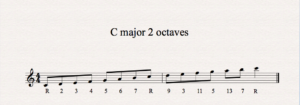The Advice Intermediate Guitar Players Guide is meant to help the player that has been studying guitar for more than a year. This page is an ongoing project, so I welcome you to make routine visits. Enjoy!
Advice for Intermediate Guitar Players: Isolate it!
Though practicing may be easier for than others some, it is simply something we all have to do if we want to get better. There is no way around it. How do you actually get better? By reading the Advice for Intermediate Guitar Players!
In order to get better you must isolate the most difficult parts of the music you are playing. For example, if you are switching from open chords to bar chords and you are constantly hearing dud-notes, (“dud” being notes that you are pressing, but are not sounding), the most inefficient use of your time would be to try to do it correctly the next time it came around. It is my guess that guitar players spent on the total hundreds of hours practicing this way and not getting much better. Think about it. If you have to wait to try and play the tough spot better, that is playing through the entire section so music, you are spending valuable time on stuff you already know and can do.
By isolating the most difficult section of the music, you focus on problem solving. The goal is to make the most difficult part feel and sound as easy as the easiest part of the music. Now that you have learned this from Advice for Intermediate Guitar Players, you can begin to cut lots of time and make greater gains in your skills!
Advice for Intermediate Guitar Players: Should I upgrade?

At this point, your first guitar lessons happened quite some time ago and you have learned quite a bit since then. Most people start to learn guitar on either an inexpensive guitar, or a hand-me-down. At some point every guitarist asks, “Should I upgrade my guitar?” The answer to that question varies and depends on the playability and sound of the guitar you are currently playing.
As a beginner you learned the basics, but as an intermediate player you start to develop an identity on the instrument. You might have decided that Country music is your favourite and the nylon string guitar that you started on does not get that twang you want. In that case it is best to consider a steel string acoustic guitar, or a Telecaster style electric guitar.
In order to upgrade from virtually any make and model to something substantially better, you will need a considerable amount of money. Buying a more expensive guitar does not necessarily mean you will be getting a better instrument, despite brand name appeal.
The Intermediate Guitar Guide has been written as always to save you time and money. The Miami Guitar Workshop can help you make the best decision when spending your hard-earned cash, so that you can get an instrument that will sound well, look good, and play easily!
Check out this great article:
Upgrade Your Original Guitar or Buy a New Ax?
If it feels good and sounds good, do it!
While I was writing, the Intermediate Guitar Guide a student of mine asked me, “Should I learn Jazz chords?” I simply said, “Sure! If it feels good and sounds good, do it!”
Learn everything and anything you can get your hands on. I remember getting a book which is now considered a famous book amongst guitar teachers. The book was, “Chord Chemistry,” by Ted Greene.
I did not understand what I was getting my hands to do, but that did not matter. I was creating new sounds and getting used to the new grips (“grips” being the new finger positions).
Playing the guitar is about tapping into the endless inspiration that the fret board has to offer. Jazz chords will introduce you to sounds that might at first sound strange. Over time you will learn to hear the beauty that is contained within. Also, learning Jazz chords may lead you towards expanding your repertoire in directions you never thought of.
There are many facets of guitar to learn and at Miami Guitar Workshop you will learn in such a way that you will become a complete guitarist.
When you are ready, you’re ready!
One of the brilliant things about playing music is sharing the music you have worked so hard on learning. An easy way to do that is to find an open mic to perform at. In order to answer the question, “How do I know when I will be ready to play at an open mic?” This is the question the Advice for Intermediate Guitar Players guide will answer for you!
 First and foremost, you must know the song or tune that you are going to perform inside and out. You must be able to perform it with ease and feeling. Also, I prepare each student on how to deal with mistakes and mishaps. Naturally, it is best to not have them, but even the best most experienced musicians make mistakes, or a situation pops up that they were not expecting. I will teach you how to deal with unexpected while not losing a beat.
First and foremost, you must know the song or tune that you are going to perform inside and out. You must be able to perform it with ease and feeling. Also, I prepare each student on how to deal with mistakes and mishaps. Naturally, it is best to not have them, but even the best most experienced musicians make mistakes, or a situation pops up that they were not expecting. I will teach you how to deal with unexpected while not losing a beat.
It can be easy to get overwhelmed with the thought of performing on a stage in front of strangers. At the Miami Guitar Workshop, I work closely with every student. “Being ready” entails quite a bit. Even though a guide for an Intermediate Guitar Player can contain quite a bit, topics such as; “Which songs to play? How long should I play?”, and “How should I prepare myself?”, are all questions that whose answered must be tailor made for each individual, which is why it is best to make an appointment, so I can best help prepare you for your big moment!
Numbers mean something
When I was good enough to just start learning songs, I decided it was time to by a songbook. My first book had so many songs that I wanted to learn and since the chord grids were also included, I was very hopeful. I noticed that many of the chord grids had numbers listed in the chord symbols. For example; “C9,” “A13.” I always wondered, “WHAT are those numbers next to the chord symbol?” I wished there was a place that I could get advice for intermediate guitar players, but there wasn’t! Anyways, since the fingering was included in the chord grid, I did not care, but I also was in the dark. It was only years later that I learned and actually understood what the numbers meant. Since the dark ages of music education are long gone and you are here reading the Intermediate Guitar Guide, it is quite simple to explain.
There are 8 notes in a Major scale; C, D, E, F, G, A, B, C. After the last C, the scale simply starts again and after the number “8,” which is also the same note as the root, the next note “D” becomes “9,” and so on. You will notice on the music example the numbers 10, 12, and 14 are not used. This is a Jazz way of digesting the music theory. It is quick and to the point. I have included a video which explains this idea on the piano, which is a fantastic instrument to be able to visualize this on.
Cue to :50
Chord Extensions 9ths, 11ths & 13ths | Extended Jazz Piano Chords
Extended jazz piano chords create a richer and more complex sound than triads and 7th chords and so they are used in jazz music to create more interesting harmonic progressions. This lesson provides an introduction to chord extensions, explaining what they are and where they come from.



